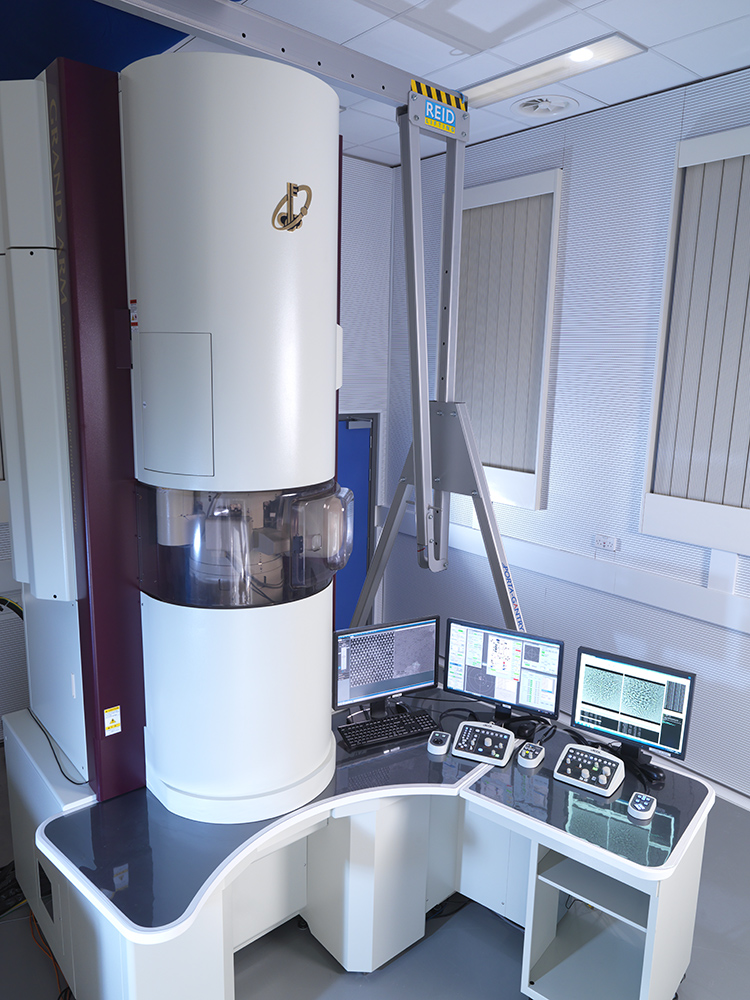
Description of the infrastructure:
The EM group within the Department of Materials at the University of Oxford is the largest group specializing in EM in the UK. The EM group has active research programs in method and instrument development (new electron detectors, exit wave reconstruction ptychography and optical sectioning) and in the application of these to catalysis, ceramics, low dimensional materials and semiconductors.

The Zeiss Auriga features a Schottky field emission Gemini electron column operating between 100V and 30kV, capable of resolutions of 1.0nm at 15kV and 1.9nm at 1kV. The SEM column is coupled with an Orsay Physics “Cobra” Ga+ ion FIB operating between 1kV and 30kV.
The Zeiss n-Vision 40 features a Schottky field emission Gemini column operating between 100V and 30kV and a SIINT Zeta Ga+ ion FIB column operating between 1kV and 30kV.
The JEOL 2200MCO is a double Cs corrected instrument for aberration corrected TEM and STEM imaging, with an in-column omega energy filter and double Wien filter monochromator with an energy resolution of 26meV. It is aligned for operation at 80 and 200kV in both modes. It provides a resolution of 100pm at both 200 and 80kV in both TEM and STEM
The JEOL ARM200CF offers a probe Cs corrected cold FEG instrument, optimised for high resolution STEM and analysis at 80 and 200kV. It is fitted with a large solid angle EDX detector and a Quantum spectrometer for EELS. The instrument also has a fast pixellated detector (PNSensor) suitable for 4D STEM data acquisition. It provides a STEM resolution of 80pm at 200kV.
For both of the above instruments an in-situ single tilt heating holder (DENS solutions) is available.
The JEOL ARM300F offers a double Cs corrected cold FEG instrument optimised for ultrahigh resolution aberration corrected TEM / STEM imaging over a range of voltages from 30-300kV. It is fitted with an Oxford instruments X-max large solid angle EDX detector and a fast direct counting electron detector (Medipix3 with Merlin Readout) for 4D STEM acquisition. We also have available a range of in-situ specimen holders for heating, cooling and biasing experiments together with a cryo transfer holder. It has a resolution of 47pm in TEM/STEM at 300kV and 130pm at 30kV. Optimised software for low dose TEM / STEM data acquisition is available,
Both DCCEM and ePSIC have access to extensive computational facilities for image simulation and data processing. These include local GPU based computation and access to large scale CPU and GPU based clusters.3
- How Transnational Access works?
- Request for access
-
Installations
- Access to StEM Stuttgart
- Access to ERC Juelich
- Access to CEMES Toulouse
- Access to LPS Orsay
- Access to EMAT Antwerp
- Access to OXTEM Oxford
- Access to WEMS Cambridge
- Access to K7 Ljubljana
- Access to FELMI-ZFE Graz
- Access to LMA Zaragoza
- Access to Advanced DME Cadiz
- Access to IC-EM Krakow
- Access to CMAL Chalmers
- Access to Gemini Centre Trondheim
- Access to Beyondnano EM lab Catania
